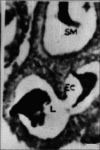Effects of Pygidial Secretion (Zoopesticide) on Histopathological Changes in the Male Accessory Reproductive Glands of Adult Male Insect Odontopus varicornis in Relation to Reproduction
- PMID: 21042469
- PMCID: PMC2964745
- DOI: 10.4103/0971-6580.68345
Effects of Pygidial Secretion (Zoopesticide) on Histopathological Changes in the Male Accessory Reproductive Glands of Adult Male Insect Odontopus varicornis in Relation to Reproduction
Abstract
Indiscriminate use of pesticides for the eradication of pests causes tremendous changes to the environment and also to other nontarget organisms. To prevent such contamination of the environment and save nontarget species, zoopesticides are increasingly used as they are cost effective, eco-friendly, safe, and sustainable in the field of agriculture. The present study was undertaken to find out the effect of pygidial secretion (zoopesticide) on Odontopus varicornis. The insects were exposed to pygidial secretion for 24, 48, 72, and 96 hours and its sublethal concentration was found to be about 2.8% for 48 hours. When the insects were injected with sublethal concentration 2.8% for 48 hours, the study revealed certain remarkable changes in the histopathology of the male accessory reproductive glands (MARGs) such as disintegration of epithelial cell wall, swollen nucleus, vacuolization of cytoplasm, highly pycnotic and necrotic epithelium, enlargement of epithelial cells, and disorganized tissues. It is suggested that zoopesticide causes several histopathological damages in the MARGs of O. varicornis and affects the reproductive potentiality of O. varicornis.
Keywords: Male accessory reproductive glands; Odontopus varicornis; pygidial secretion.
Conflict of interest statement
Figures









References
-
- David VB, Kumaraswami K. Madras: Popular Book Depot; 1998. Elements of Economic Entomology.
-
- Selvisabhanayakam . Annamalai university; 1995. Studies on reproductive physiology with special reference to mating in the adult male insect Odontopus varicornis (Dist.) (Heteroptera: Pyrrhoccoridae) Ph.D., Thesis.
-
- Gillott C. Male accessory gland secretions: Modulators of female reproductive physiology and behavior. Ann Rev Entomol. 2003;48:163–84. - PubMed
-
- Forsyth DJ. The structure of the pygidial defence glands of carabidae (coleoptera) Trans Zool Soc Lond. 1972;32:249–309.
-
- Moore BP. Hague: Junk publishers; 1979. Chemical defense in carabids.
LinkOut - more resources
Full Text Sources

